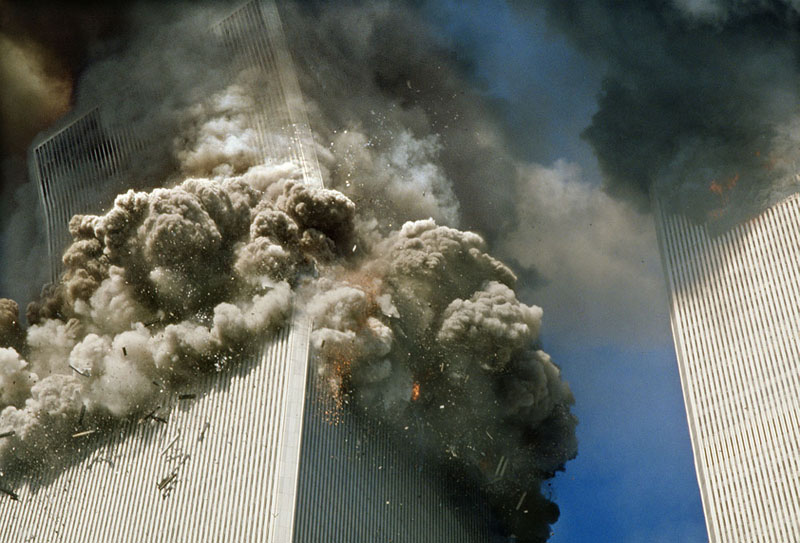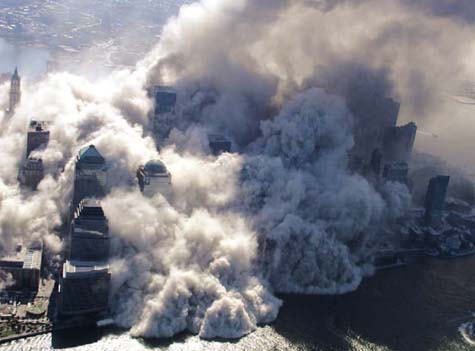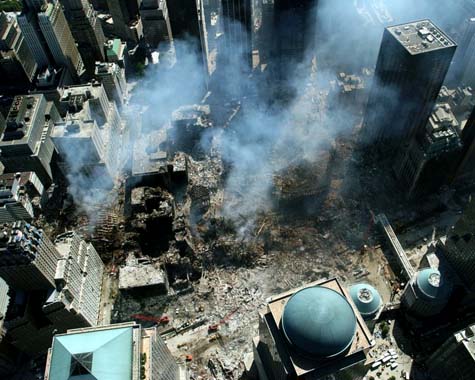Inhaling 9/11
 [Image: The South Tower of the World Trade Center on 9/11; photographer unknown].
[Image: The South Tower of the World Trade Center on 9/11; photographer unknown].On the flight over to Chicago last week I read an intense and frightening article in Discover about the wide range of post-9/11 illnesses that have begun to develop in New York City.
As most people no doubt know, tens upons tens – if not hundreds – of thousands of people literally inhaled the World Trade Center towers in the collapse and aftermath of 9/11.
It was the malign aerosolization of late modernist architecture, producing "the most dangerous atmospheric conditions ever to occur on American soil."
The "sky was glittering with glass" that day:
- A toxic cloud composed of industrial waste and human remains crept out from the aching, smoldering pit at Ground Zero and wound its way into the adjoining streets. Its vapors circled around and up buildings, pumped in and out of nostrils, mouths, and lungs, and stung the eyes of every woman, child, man, bird, and beast within a wide range. It spread itself on building walls and inside boiler rooms and left its trail on parked cars, handrails, and public benches. That day, New York City was blinded by a perpetually sickening haze. It poisoned the minds of politicians who acted with hubris and paranoia. It obscured the vision of responders and residents, many of whom acted with heroism and reckless bravado, never thinking that their actions might be endangering themselves, their families, their cities, and their very future. The cloud billowed southward, over the river, enveloping everything in the dust and debris of blown-apart lives.
Indeed, the "number of seriously ill New Yorkers could climb to 300,000 in the near future," and these serious illnesses run the gamut from "internal chemical burns" and "chronic respiratory and gastrointestinal conditions," many of which will be fatal, to "rare blood cancers" and asthma attacks.
 [Image: "Within a few hours’ time, a person exposed to the fumes could ingest toxins that would otherwise take a year to accumulate in a typical environment"; photographer unknown].
[Image: "Within a few hours’ time, a person exposed to the fumes could ingest toxins that would otherwise take a year to accumulate in a typical environment"; photographer unknown].None of which seems surprising when you read about what actually went up in the air that day:
- The Twin Towers contained tens of thousands of computer terminals, each housing about four pounds of lead, and an untold number of fluorescent bulbs that contained mercury. Released metal particles from the smoldering pit of the World Trade Center were so fine that they could easily slip past a paper face mask and reach deep into lung tissue, where they are poorly soluble in lung fluid. Metals and glass can remain trapped there for long periods of time and make their way into the heart.
 [Image: After the towers' collapse; photographer unknown].
[Image: After the towers' collapse; photographer unknown].After much more detail about both the "plume" itself and about the various environmental failures that occurred up and down the political chain of command, the article ends magnificently: "While the courts try to determine who is responsible for the environmental debacle following 9/11, countless New Yorkers continue to live and work near Lower Manhattan with the assumption that it is safe. The dust is now out of sight, out of mind, and possibly in their lungs, hearts, and bloodstreams."
So this is what happens when you pulverize and burn modern architecture: plumes of cadmium, thallium, benzene, silver, zinc, osmium, carbon monoxide, sulfuric acid, nickel, and lead drift outward into the city, snowing invisibly into local waterways, settling on windowsills and dusting the floors of homes, shops, and offices, salting food on plates at outdoor cafes, entering bloodstreams and sticking to clothes. Fiberglass and fire retardants, arsenic and rubber – asbestos, soot, and paper – all enter the atmosphere and form undetectable weather systems too vaporous and ghostlike to track.
Which leads me to wonder about what sort of post-bombardment aerial conditions existed in cities like Dresden or Hiroshima, after they were destroyed in World War II, when architecture was not made from such things – when there were not home computers and circuitboards to burn and when homes weren't full of flame retardant fabrics and PVC.
Were different and earlier forms of pulverized architecture somehow safer to breathe?
In fact, if I can be excused a brief moment of contextually inappropriate speculation, would it be possible to impregnate buildings with good things – with good chemicals: with vitamins and medicines and even seeds – so that future 9/11s release beneficial plumes and so that the inhalation of architectural smoke is no longer catastrophic?
Or would that just encourage terrorist attacks, arson, and urban warfare?
In any case, the article in Discover is well worth a half-hour or so of your time – especially if you lived or worked in lower Manhattan or Brooklyn during the weeks after 9/11.





Comments are moderated.
If it's not spam, it will appear here shortly!
I visited the site a month after the attacks and spent the next day and a half blowing black snot out of my nose.
Of course, the White House was on the case...
I walked over the bridge to brooklyn and this was late afternoon and the hole in thr ground was huge even from the bridge and still pouring out smoke.
It was cinematic, thousands walking like refugees, which is exactly what we were.
Heres another view of what happened.
http://video.google.com/videoplay?docid=-4762034487703351799
That was a great post, I had to read it all once I started. I remember watching it on TV on 9/11, and the images brought back some memories of that day.
Matt at http://www.goodnightmoonfuton.com
It's staggering to think of those vaporized computers and fluorescent bulbs ... now moving through weather systems and bodies...
Joseph Masco writes about the standardization of a "background radiation" measurement to compare against exposure at nuclear bomb tests. Of the 360 millirems/year we're exposed to, 60 come from nuclear bomb testing, nuclear medicine, and nuclear power... The "natural" exposure nowadays includes the 60 millirems accumulated in the biosphere since the 1940s...
He quotes from the US Dept. of Health: "Any person living in the contiguous United States since 1951 has been exposed to radioactive fallout, and all organs and tissues of the body have received some radiation exposure."
Yes, the fires at the WTC burned until December of 2001.
But this post is a bit of a wank.
I lived in NYC on and after 9/11, and what a lot of people don't realize is just how long the fires kept burning -- almost two months, if memory serves.
At the same time, traffic between lower Manhattan and Brooklyn was at a virtual standstill; on the few unhappy occasions when I had to drive from upper Broadway to Atlantic Ave., I ended up in traffic jams that were periodically smothered in smoke with an absolutely indescribable smell, which was enough to trigger PTSD in and of itself.
Were different and earlier forms of pulverized architecture somehow safer to breathe?
My gut feeling is that they probably were, although the use of asbestos, heavy metals, and plastics were pretty heavy back in the forties. Also, there's the massive postwar technology transfer to consider, with military compounds and processes being marketed for civilian use.
Beyond that, it seems reasonable to assume that the smoke produced by London in 1666 was less toxic than it'd be if a comparable area of the city burned down today, particularly in terms of persistence, bioaccumulation, etc.
But this post is a bit of a wank.
It seemed pretty serious and sober to me. Go figure!
"Or would that just encourage terrorist attacks, arson, and urban warfare?"
Or discourage it, for the possibility that destruction would cause more good than harm?
Only few seconds earlier here in Chicagoland, a public service announcement (with sock puppets!) by a PBS station out of northwest Indiana told us that we shouldn't dump expired birth control pills and AIDS medication -- all prescription medication, in fact -- because they're toxic and will end up in our drinking supply. Instead they should be taken to places that handle hazardous waste material.
Which leads me to wonder whether New Yorkers also inhaled pulverized Viagras, Claritins, Lipitor, AZTs and all manners of pills stored in the towers. An as yet untold story maybe that of someone cured of his allergy or depression because they inhaled 9/11.
"9/11 didn't make me cough up blood. It lowered my cholesterol."
"Pulverized architecture turned me into a sex machine."
my video of that day:
http://www.vimeo.com/300236
"Which leads me to wonder whether New Yorkers also inhaled pulverized Viagras..."
If they ever make the movie, fewgawds sake don't do the old 'collapsing tower footage run backwards'... Trains into tunnels, waves on a shore, fine, but no erectile architecture.
if I can be excused a brief moment of contextually inappropriate speculation, would it be possible to impregnate buildings with good things – with good chemicals
With this and your recent visit to Chicago, I'm wondering if somewhere in your synapses a connection was made. Made by chocolate. As someone who lives in chicago now, I have to wonder just how much fine chocolate particles have been spread over chicago's architecture by the Blommer's company. Maybe there can be tax credits for industries of not just chocolate, but flowers and fresh bakeries (my old ride home on Grand past one just over the river too) to be built in city centers. Or is that too pie-in-the-sky, if you forgive the pun.
Just thought you might be interested in this Microscopic analysis of WTC dust by Nicholas Petraco, BS, MS, DABC, FAAFS, FNYMS at The New York Microscopic Society lecture held at AMNH 28 May 2003
45.1% Fiberglass, rock wool (insulation, fireproofing)
31.8% Plaster (gypsum), concrete products (calcium sulfate, selenite, muscodite)
7.1% Charred wood and debris
2.1% Paper fibers
2.1% Mica flakes
2.0% Ceiling tiles (fiberglass component)
2.0% Synthetic fibers
1.4% Glass fragments
1.3% Human remains
1.4% Natural fibers
trace asbestos (it became illegal to use during the construction of the WTC)
Other trace elements: aluminum, paint pigments, blood, hair, glass, wool with resin, and prescription drugs were found.
"the use of asbestos, heavy metals, and plastics were pretty heavy back in the forties."
I doubt there was much plastic in Dresden, Coventry, Hamburg or any of the other old cities flattened during WW2. I've never heard of cases of "fallout" (so to speak) in Europe on anything like a par with the effects of the Twin Towers' collapse. Most of the buildings being bombed during WW2 were 19th century (or older) structures made of wood, brick and stone. There would have been some asbestos, of course, and lead pipes.
Who needs "dirty bombs" when we've got cities full of toxic material waiting to be released?
Who needs "dirty bombs" when we've got cities full of toxic material waiting to be released?
Interestingly put.
Anonymous left a video link that I've had to reformat for margin purposes; here's the link.
Post a Comment